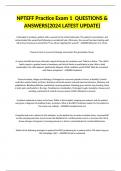NPTEFF Practice Exam 1 QUESTIONS &
ANSWERS(2024 LATEST UPDATE)
A therapist is treating a patient with a wound on the ischial tuberosity. The patient is incontinent, and
contaminated the wound bed following an accidental leak. Otherwise, the wound has been healing well.
What level of pressure should the PT use when irrigating the wound? - ANSWER Between 4 to 15 psi.
Pressure close to 4 prevent damage and protect the granulation tissue.
A 4-year-old child has been referred to physical therapy for weakness and "failure to thrive." The child's
family reports a gradual onset of weakness and lack of desire to participate in play. After a brief
examination, the child appears significantly fatigued. What condition would MOST likely be consistent
with these symptoms? - ANSWER Leukemia
General malaise, fatigue and lethargy, Prolonged or recurrent episodes of fever, Irritability, Growth
restriction and/or failure to thrive, Shortness of breath and/or reduced exercise tolerance, Dizziness and
palpitations, Bleeding diathesis, particularly causing epistaxis, bleeding gums and/or easy bruising, Bone
or joint pain, particularly in the legs, Troublesome constipation, Prolonged cough, Headache, Nausea and
vomiting, particularly if central nervous system (CNS) infiltration is present.
A patient sustained an injury to his knee. While in the hospital, imaging was ordered, and the patient
was given a diagnosis of popliteal artery occlusion. What is the BEST treatment option for this patient in
the acute care setting? - ANSWER Complete bed rest
Complete bed rest is advised in this situation, as the patient has an active occluded artery. Increased BP
via the pumping exercises may increase the likelihood of a cardiovascular event, or increase the risk of
tissue damage via hypoxia. Increasing pressure or heat is contraindicated in arterial deficiencies.
Which of the following strategies is optimal for BEST positioning for a patient with a CVA when lying on
the hemiplegic side? - ANSWER Forearm supinated
,Effective positioning of the hemiparetic extremities encourages proper joint alignment while positioning
the limbs out of the abnormal postures typically assumed. When lying on the more affected side,
forearm should be should be kept in supination.
A patient with a tracheostomy tube has been hospitalized for two days. During physical therapy the
patient suddenly exhibits dyspnea, cyanosis of lips, and cramping of the right calf muscle. What should
the therapist suspect based on the symptoms? - ANSWER Respiratory Distress
Dyspnea, shortness of breath, or cramping in the calf muscles are common signs of respiratory distress.
Mucus plugging, tube displacement, disruption or disconnection of oxygen can cause respiratory distress
in a tracheostomy patient.
A PT Assistant was treating a patient status post ACL reconstruction and asked the patient to complete
knee extension exercises that were not in the original plan of care. After completing the exercises, the
patient's pain was exacerbated and later determined that they were injured during the PTA's care. In this
scenario, who is MOST responsible for the patient's injury? - ANSWER The treating physical therapy
assistant
Which of the following is the MOST commonly dislocated joint in the shoulder? - ANSWER Glenohumeral
joint
Glenohumeral joint is the most mobile joint. It is a multiaxial, ball-and-socket, synovial joint that
depends primarily on the muscles and ligaments rather than bones for its support, stability. It has high
mobility but little articular stability making it the most commonly dislocated joint of the shoulder
complex.
A chronic smoker diagnosed with COPD was tested for an arterial blood gas (ABG) analysis. After
reviewing the patient's chart, the physical therapist is MOST likely to see which of the following changes
in the ABG results? - ANSWER Increased PaCO2, decreased PaO2, and decreased pH
A 70-year-old male patient presents to an outpatient clinic with sensory loss of the right face and arm.
This patient is taking medications for hypertension, diabetes mellitus type 2, and hydrocortisone for a
rash on his leg. The patient initially seems confused but otherwise has intact speech. The therapist would
MOST likely suspect a lesion in which vessel? - ANSWER Left MCA inferior division
, Infarct in middle cerebral artery inferior division causes contralateral homonymous hemianopsia, fluent
aphasia (Wernicke's area)
A 25-year-old patient had a traumatic fall off his bicycle 1 week ago. Since the injury, the patient has not
been able to elevate his scapula. Based on the information given, what is the MOST likely physical
therapy diagnosis? - ANSWER Superior dislocation of SC Joint
A PT consult is ordered for a 50-year-old gentleman in the late stages of ALS. In the patient's chart is an
electromyography report and nerve conduction velocity test. All of the following findings are consistent
with his diagnosis EXCEPT: - ANSWER Decreased sensory evoked potential
Sensory evoked potential will not be seen in ALS as ALS is a motor neuron disease affecting the motor
nerves and not sensory nerves.
To prevent maximal compressive force being placed on the patella, a therapist should avoid placing a
patient in what position? - ANSWER Prone with the knee flexed to 110 degrees and the hip in slight
extension
Positioning the patient in prone places the hip into an extended position. From this position, increasing
knee flexion to 110 degrees results in passive insufficiency of the quadriceps, which creates higher
compression at the patella.
A 39-year-old female presents to physical therapy with new complaints of increased fatigue, cold hands
and feet. Upon assessment, dependent edema was present bilaterally. Which of the following tests or
measures are the MOST appropriate for a PT examination? - ANSWER Body temperature and lung
auscultation for rales
The patient is presenting the signs of CHF
Which of the following is MOST appropriate to screen for in a patient with an acute exacerbation of
Guillain-Barre Syndrome? - ANSWER Skin Integrity
Skin integrity is most important to check as loss of sensation is dangerous.




